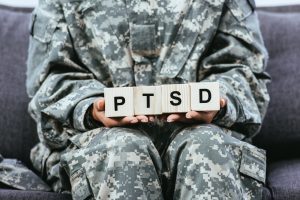 Written by Claire Szewczyk
Written by Claire Szewczyk
The first time that Post-Traumatic Stress Disorder (PTSD) reached the public eye, it was known as the concept of “shell shock” – debilitating nightmares, hyper-reactivity and increased dangerous behaviors in veterans who had experienced traumas of combat during World War I. It is still very much a common diagnosis amongst the veteran community, with an incidence of almost 13% (PTSD and veterans: Breaking down the statistics 2021).
However, in more recent years, PTSD has been a more commonly diagnosed mental health disorder that can affect anyone who was exposed to any form of abuse, trauma, or life-threatening situation.
As a result of PTSD becoming more of a common occurrence among the population, it has also become more important for those who are experiencing symptoms to seek out treatment. There are a wide variety of options available, including the tried and true, research-verified effective Cognitive Behavioral Therapy, or CBT.
CBT focuses on the relationship among thoughts, feelings and behaviors, targets current problems and symptoms, and then focuses on changing patterns of behavior that lead to difficulty functioning.
What is Post-Traumatic Stress Disorder (PTSD)?
Post-Traumatic Stress Disorder (PTSD) is a mental health condition that can develop after a person has experienced or witnessed a traumatic event, such as a combat event, a natural disaster, a car accident, or a violent crime.
Symptoms of PTSD include re-experiencing the traumatic event through flashbacks or nightmares, avoidance of reminders of the event, and increased feelings of anxiety and depression.
Most people who go through traumatic events may have temporary difficulties with adjusting and coping, but with good self-care practices and time, they usually are able to overcome it. If symptoms worsen, linger and interfere with day-to-day functioning, they might be experiencing PTSD.
Getting effective treatment after PTSD symptoms develop can be critical to reducing symptoms and improving overall function.
What is Cognitive Behavioral Therapy (CBT)?
Cognitive Behavioral Therapy focuses on the relationship between thoughts, feelings and behaviors. It targets individuals’ current concerns and issues with day-to-day-functioning and the symptoms they are experiencing, and then provides ways to help challenge negative patterns of thought and behavior, in order to help improve quality of life.
How does Cognitive Behavioral Therapy Help PTSD Symptoms?
Several theories that revolve around trauma help explain why CBT is an effective treatment to reduce symptoms of PTSD.
Emotional Processing Theory suggests those who have experienced a traumatic event can develop associations with reminders of the event. Challenging these associations, especially the ones that lead to unhealthy functioning, is the core of emotional processing.
Social Cognitive Theory suggests that those who have defined their existing beliefs about themselves, others, and the world, based on the trauma they experienced, often struggle with unhelpful interpretations of their experiences of their environment.
Cognitive Behavioral Therapy has been scientifically proven through many studies, to alleviate symptoms of PTSD. Typically, CBT treatment includes two main components: exposure therapy and cognitive restructuring.
 Exposure Therapy
Exposure Therapy
Exposure Therapy aims to reduce the emotional distress associated with reminders of the triggering event. Exposure Therapy operates similarly to how it sounds. It involves gradually exposing the individual to reminders of the traumatic event in a controlled and safe environment.
If you go through Exposure Therapy you may be asked to recall the traumatic event in therapy, visit places, or engage in activities that are associated with the traumatic event. Over time, the hope is that you will be able to identify your triggers and use coping mechanisms to downplay the symptoms you experience (Yetman, Exposure therapy: Types, how it’s done, and more 2021).
Cognitive Restructuring or Prolonged Exposure (PE) Therapy
The second aspect of CBT is Cognitive Restructuring or Prolonged Exposure Therapy (PE). PE is a type of CBT treatment that involves identifying and changing negative thought patterns associated with the traumatic event (Prolonged exposure (PE).
Cognitive restructuring may include challenging and refuting negative beliefs about oneself, the world, and others developed due to the traumatic event.
For example, a person with PTSD may believe that the world is dangerous and that they are helpless to protect themselves, which can lead to anxiety and fear.
Through Cognitive restructuring, a therapist may help the person to challenge and refute this belief and replace it with a more balanced and realistic perspective.
CBT is a scientifically proven effective treatment for PTSD
CBT is effective in treating PTSD in several studies. CBT was found to be effective in reducing symptoms of PTSD in adults in over 12-15 sessions either in a group setting or one-on-one.
CBT has also been effective in treating PTSD in specific populations, including veterans and individuals who have experienced a traumatic event in childhood. The VA and the American Psychological Association recommend using CBT for PTSD survivors. CBT not only targets PTSD but also targets other symptoms of PTSD such as depression and anxiety.
Multiple studies through the years have championed CBT for PTSD treatment. (Cognitive behavioral therapy (CBT) for treatment of PTSD).
What are the Benefits of CBT?
Besides the fact that Cognitive Behavioral Therapy is a scientifically proven effective treatment for individuals suffering from post-traumatic stress disorder, there’s also a wide variety of benefits over other forms of therapy. Here’s a few of them:
1. It gives people hope about their condition.
Oftentimes, due to the nature of mental health disorders, sometimes it can cause those who have been diagnosed to have a pessimistic outlook about their future wellbeing. It can be difficult to think about a time where their illness won’t impact their life.
CBT challenges this mindset–and offers hope for the future.
It does this by using its own methods to challenge thoughts and ideas like this. Provides a way to seek out alternative possibilities. That life could be very different, and in a more positive way.
2. It develops self-esteem.
It’s not a surprise to note that with many mental health conditions, also comes with a lower sense of self-worth and self-esteem.
This feeds into the cycle of negative thinking, which influences behaviors, and vice versa.
CBT can help disrupt these negative thoughts and patterns, and as a result, help develop more confidence in a person’s own abilities and strengths.
Understanding how thoughts work, and how they are under the control of those who are thinking them, changes things on a fundamental level. Including the way people see themselves.
3. It can help with relaxation.
Because CBT directly helps with managing thoughts and emotions, this comes with it the ability to control how a person responds to their symptoms.
As a result, it helps regulate responses to triggers and reduce symptoms by utilizing a variety of relaxation techniques.
4. It develops more rational thought processes.
Perhaps the most important benefit of CBT, is that it helps people regain control of their thoughts and emotions.
Over time, the process of questioning and challenging our thought processes, and replacing them with healthier ones, can transform people entirely.
CBT is a great way to treat PTSD
In conclusion, CBT is a widely recognized and effective treatment for PTSD. This type of therapy is based on the idea that our thoughts, feelings, and behaviors are interconnected and that we can change our emotional response to a traumatic event by changing our thoughts and behaviors.
Through exposure therapy and cognitive restructuring, CBT can help individuals reduce symptoms of PTSD, such as re-experiencing the traumatic event, avoiding reminders of the event, and decreasing feelings of anxiety and depression.
 Author Bio:
Author Bio:
Claire Szewczyk is a Digital Content Coordinator for Hill & Ponton, PA in Florida. She was a former US Airforce civilian employee, who worked at Hill Air Force Base, in Layton, UT as a flight testing administrator. She has also spent several years working with the Department of Veterans Affairs audiology programs in Salt Lake City, UT and Pocatello, ID. She enjoys working with the Veteran population and keeping them up to date with information they need the most.
Please also review AIHCP’s Anger Management Specialist Certification and see if it meets your academic and professional goals. The program is online and independent study and open to qualified professionals seeking a four year certification in Anger Management Counseling.
References
American Psychological Association. (n.d.). Cognitive behavioral therapy (CBT) for treatment of PTSD. American Psychological Association. Retrieved January 30, 2023, from https://www.apa.org/ptsd-guideline/treatments/cognitive-behavioral-therapy
American Psychological Association. (n.d.). Prolonged exposure (PE). American Psychological Association. Retrieved January 30, 2023, from https://www.apa.org/ptsd-guideline/treatments/prolonged-exposure
Emotional processing theory (EPT) and exposure therapy for … – springer. SpringerLink. (n.d.). Retrieved January 26, 2023, from https://link.springer.com/article/10.1007/s10879-006-9008-y
PTSD and veterans: Breaking down the statistics. Hill & Ponton, P.A. (2021, May 11). Retrieved January 30, 2023, from https://www.hillandponton.com/veterans-statistics/ptsd/
Yetman, D. (2021, June 21). Exposure therapy: Types, how it’s done, and more. Healthline. Retrieved January 30, 2023, from https://www.healthline.com/health/exposure-therapy#:~:text=Exposure%20therapy%20is%20a%20kind,therapist%20in%20a%20safe%20environment.
